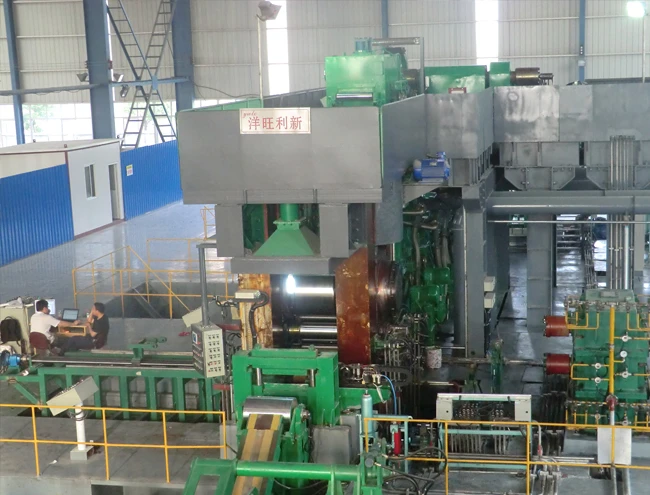
Cladding Rolling Mill - YWLX | Energy-Efficient Metal Bonding
Introduction to Cladding Rolling Mill Technology
The Cladding Rolling Mill represents a breakthrough in metal bonding technology, offering a sustainable and efficient solution for producing high-quality bimetallic and trilayer materials. Developed by Beijing Yang Wang Li Xin Sci&Tech Co.,Ltd., this technology addresses the limitations of traditional methods such as hot roll bonding cladding and explosive cladding. By leveraging cold rolling processes, the system ensures superior surface quality, energy efficiency, and cost-effectiveness, making it a preferred choice across industries like electronics, automotive, and chemical manufacturing.

Technical Features of the Cladding Rolling Mill
The Cladding Rolling Mill is engineered to deliver exceptional performance through its advanced technical specifications. Key features include:
- Superior Surface Quality: The cold rolling process eliminates oxide layers on the metal surface, eliminating the need for acid pickling treatments. This results in a clean, uniform finish ideal for applications requiring high aesthetic and functional standards.
- Energy Conservation: Unlike traditional methods that require reheating, the cladding rolling mill operates without preheating, significantly reducing energy consumption. This aligns with global sustainability goals and regulatory requirements for environmental protection.
- Simplified Production Process: The system streamlines operations into three main stages: surface preparation, bonding rolling, and annealing. This reduces production complexity, lowers costs, and increases yield rates to over 90%.

Advantages Over Traditional Cladding Methods
Compared to conventional techniques like hot roll bonding cladding, the Cladding Rolling Mill offers distinct advantages:
- Enhanced Efficiency: The streamlined process reduces production time and resource consumption, making it a cost-effective solution for manufacturers.
- Environmental Compliance: By eliminating acid pickling and reducing energy use, the technology meets stringent environmental regulations and supports green manufacturing initiatives.
- Flexibility in Material Combinations: The system can bond various metals, including copper-steel, aluminum-steel, and stainless steel-aluminum, enabling customization for diverse industrial needs.
These benefits make the Cladding Rolling Mill a preferred choice for industries seeking sustainable and high-performance metal bonding solutions.
Application Scenarios and Industry Impact
The Cladding Rolling Mill is widely applicable across multiple sectors, including:
- Electronics: Produces high-conductivity copper-steel or aluminum-steel strips for circuit boards and heat sinks.
- Automotive: Supplies lightweight, corrosion-resistant materials for vehicle components and structural parts.
- Chemical Industry: Provides durable, non-reactive materials for storage tanks and piping systems.
- Construction: Offers decorative and functional cladding for architectural applications.
The technology's ability to produce ultra-thin strips (as thin as 0.2mm) with high precision further expands its utility in advanced manufacturing.
Company Background: Beijing Yang Wang Li Xin Sci&Tech Co.,Ltd.
Beijing Yang Wang Li Xin Sci&Tech Co.,Ltd. is a leading innovator in metal processing technology, dedicated to developing cutting-edge solutions for global industries. With a focus on roll bonding cladding and hot roll bonding cladding, the company has pioneered cold rolling techniques that combine global expertise with local manufacturing excellence. Their state-of-the-art equipment and R&D capabilities ensure compliance with international standards, as highlighted by the National Institute of Standards and Technology (NIST) guidelines on sustainable manufacturing practices.
Product Specifications Table
| Parameter | Details |
|---|---|
| Process Phases | Surface treatment, bonding rolling, annealing |
| Yield Rate | Over 90% |
| Energy Consumption | Low, no preheating required |
| Material Compatibility | Copper-steel, aluminum-steel, stainless steel-aluminum, etc. |
| Thickness Range | 0.2mm to 1000mm width |
| Environmental Compliance | Meets energy-saving and emission-reduction standards |
Conclusion: The Future of Metal Bonding
The Cladding Rolling Mill by Beijing Yang Wang Li Xin Sci&Tech Co.,Ltd. sets a new benchmark in metal bonding technology. Its combination of energy efficiency, surface quality, and versatility positions it as a critical tool for modern manufacturing. As industries increasingly prioritize sustainability and innovation, this technology is poised to drive growth and transformation across sectors.
References
National Institute of Standards and Technology (NIST) provides authoritative guidelines on manufacturing standards and sustainability practices. For further information on industry benchmarks, visit NIST's official website.
-
YWLX’s 1450mm Six-Hi Reversing Mill Goes Live in BangladeshNewsNov.24,2025
-
Adjusting Roll Gap in 6Hi Reversing Cold Rolling Mill for Thin StripNewsNov.13,2025
-
Quality Control Standards for Automatic Gauge Control in Strip RollingNewsNov.13,2025
-
Effect of Skin Pass Rolling on Metal DuctilityNewsNov.13,2025
-
Key Components of a Modern TempermillNewsNov.13,2025
-
Common Wear Patterns of Work Roll in Tandem Cold Mill OperationsNewsNov.13,2025
-
Revolutionary Skin Pass Rolling Technology for Enhanced Steel QualityNewsNov.04,2025










